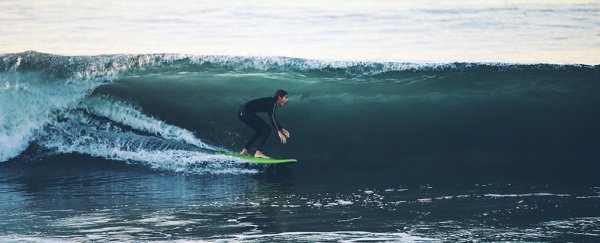Scientists have figured out exactly where on a wave surfers need to hit to get the fastest speeds and the best ride – but the discovery can also be used in studies of weather and climate, not just giving surfers a boost.
The analysis is based on the physics of how air and water interact, and how wave's energy is transferred to particles touching its surface, such as those in a solid surfboard.
According to the team from the Scripps Institution of Oceanography at the University of California, the idea behind the research is to get a better understanding of ocean waves that can then be used in models of weather changes across the globe.
"Based upon the speed and geometry of the wave, you can determine the conditions to surf a wave and also where on the wave the maximum acceleration, or 'sweet spot', will be located," says lead researcher and avid surfer Nick Pizzo.
Based on the researchers' calculations, the sweet spot is right in the curl of a breaking wave. For maximum forward motion, the particles (or the surfboard) should be travelling along at the same speed as the wave itself.
That might not be a surprise to seasoned surfers, but it helps us to figure out the broader physics of the ocean.
"By studying the acceleration of a theoretical surfer on a wave, we can provide a better description of the currents generated by breaking waves, leading to an improved understanding of the momentum and energy budget between the atmosphere and ocean," says Pizzo.
Breaking waves aren't as common out at sea as they are close to the shore, but as waves break they create currents, and water droplets in the form of sea spray get thrown up into the atmosphere.
The interactions of these tiny events can help to predict storms and hurricanes, as well as model long-term changes in the climate, so the benefits of the research could eventually go way beyond the surfing community.
With water covering about 71 percent of the Earth's surface, the oceans play a significant role in how our climate evolves and vice versa, and scientists are working hard to find links between what's happening underwater and what's happening in the atmosphere.
For the record, the biggest wave we've ever recorded was a 19 metre (62.3 foot) monster logged in the North Atlantic Ocean between Iceland and the UK in February 2013. Surfing in on something that size would be quite an experience.
Pizzo plans to continue investigating the complex interactions between ocean waves and the atmosphere, so this might not be the last surfing-related piece of climate science we hear about.
"We need to understand the little things to get the big picture," says Pizzo.
The research has been published in The Journal of Fluid Mechanics.
The team also put together a short video on the research, which you can see below:
